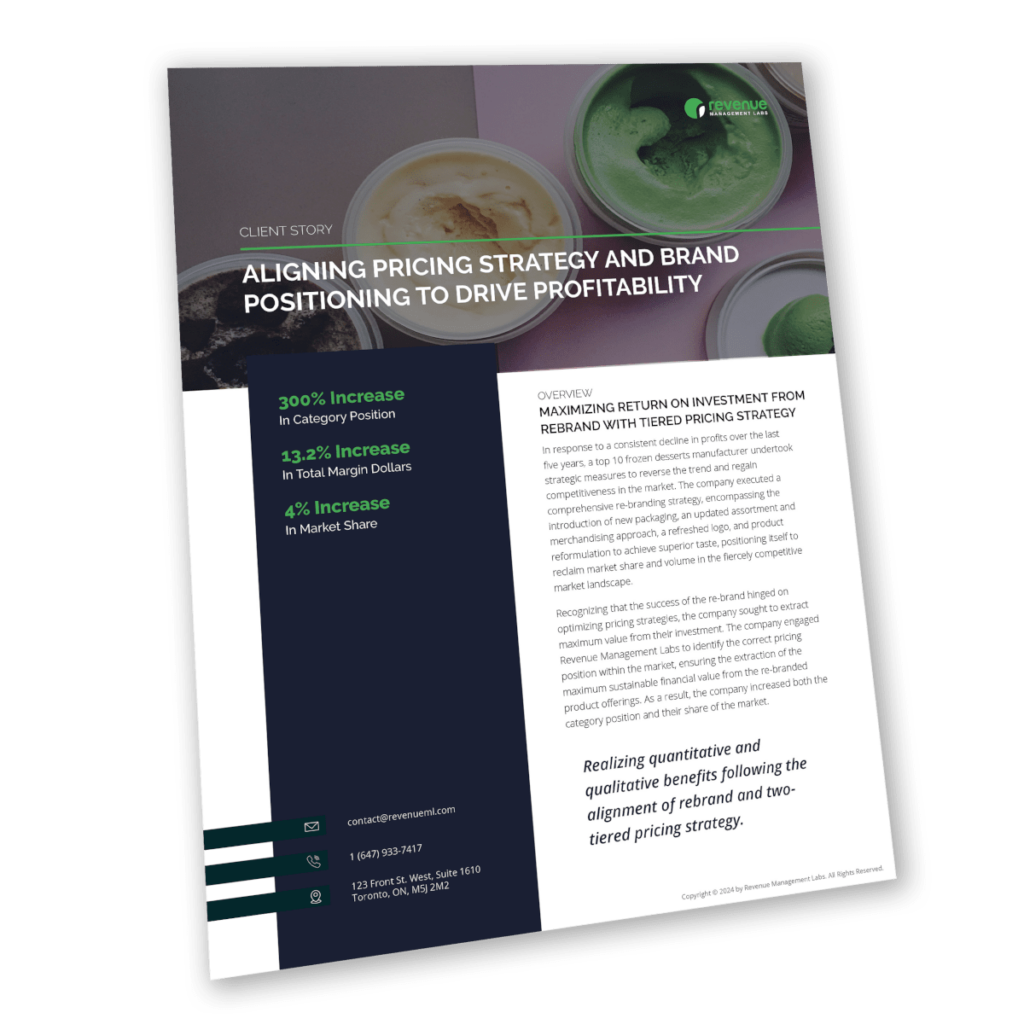Realizing quantitative and qualitative benefits following the alignment of rebrand and two-tiered pricing strategy.
In response to a consistent decline in profits over the last five years, a top 10 frozen desserts manufacturer undertook strategic measures to reverse the trend and regain competitiveness in the market. The company executed a comprehensive re-branding strategy, encompassing the introduction of new packaging, an updated assortment and merchandising approach, a refreshed logo, and product reformulation to achieve superior taste, positioning itself to reclaim market share and volume in the fiercely competitive market landscape.
Recognizing that the success of the re-brand hinged on optimizing pricing strategies, the company sought to extract maximum value from their investment. The company engaged Revenue Management Labs to identify the correct pricing position within the market, ensuring the extraction of the maximum sustainable financial value from the re-branded product offerings. As a result, the company increased both the category position and their share of the market.
Rebranding provides a strategic opportunity to optimize pricing, ensuring that the pricing strategy aligns with the new brand positioning and resonates with the target market. For the frozen desserts manufacturer, the declining profits over the past five years was the predominant issue that the rebrand and a pricing strategy would solve.
At the time of their rebrand, the company relied on a cost-plus model driven by a heavy emphasis on input and commodity costs such as milk and sugar. At least one of their pricing inputs, milk is inherently volatile due to seasonality, its perishable nature, and unanticipated variation in supply in combination with inelastic demand. Cost volatility leads to difficulties in tracking and pricing with the cost-plus pricing model. The second significant drawback in their current pricing method is that it overlooks the perceived value of their products and the customer willingness to pay.
In Category Position
In Total Margin Dollars
In Market Share

Review the advanced analytics behind our pricing strategy and the increase in revenue.
The pricing experts at Revenue Management Labs developed a value-based pricing strategy through a comprehensive approach to data analysis, which examined customer willingness to pay and market conditions. Our research uncovered several key insights, leading to segmenting their offerings into two categories, premium and core and tiered pricing. We recommended a price increase of .50 cents for the premium category to $5.49 and maintaining the price of the core category at $4.99.
The second part to the solution focused on sales strategy and execution with retailers. We established hard guidelines on which programs to offer each retailer, combining elements of displays, feature, and price, to increase return on investment for both retailer and the company. We also provided sell stories specific to retailers that focused on the margin upside to smooth the acceptance of the price change.
Revenue Management Labs designed a systematic and data-driven methodology to develop an effective pricing strategy, focusing on a comprehensive understanding of both the market dynamics and the customer’s perception of the brand’s value. The method encompassed three key phases:
analyzing the national market data, surveying and evaluating the customer’s willingness to pay and validating through transaction analysis, and assessing retailer and company return on investments of promotional tactics.
For a detailed review of the pricing methodology and data analysis,
download the full case study on price strategy and brand positioning for frozen dessert manufacturers.
The executed re-brand and two-tiered pricing strategy significantly boosted the company’s market position, yielding a four percent improvement in market share and a double-digit increase in percent margin of 13.2%. The engagement also resulted in a remarkable 300% increase in category position. Support for sales included the establishment of a clear consumer segmentation strategy and the development of brand guidelines for cohesive messaging. The engagement also identified key pipeline initiatives to drive incremental sales. Beyond financial gains, these outcomes reflect strategic progress in market positioning, consumer engagement, and the establishment of a robust foundation for future growth, solidifying the company’s leadership in the market.
We are here to help you achieve profitable revenue growth
Phone: +1 (647) 933-7417
Inquiries: contact@revenueml.com

We will cover the full results from our 2024 Executive Pricing Survey. See how you compare to your competitors both in past performance and for 2024 pricing strategy.